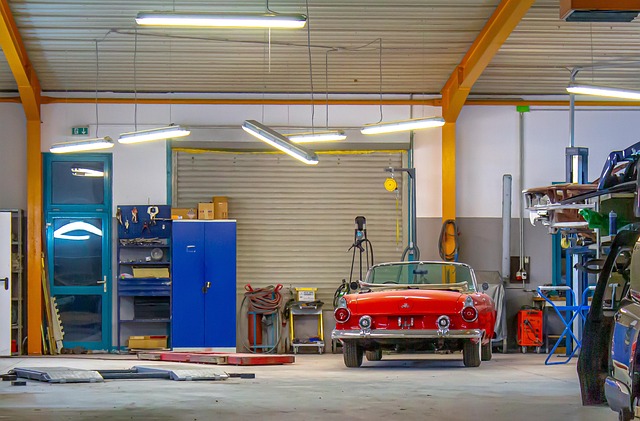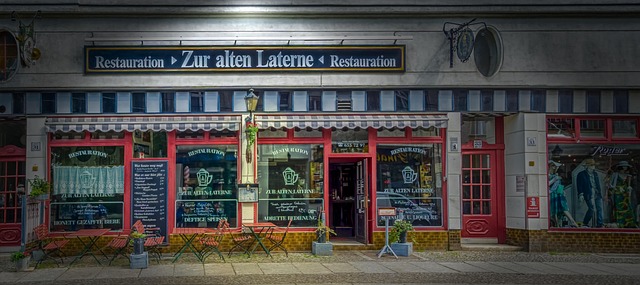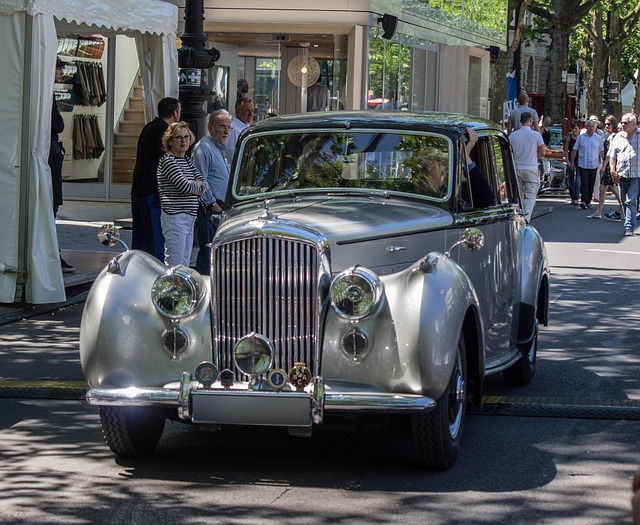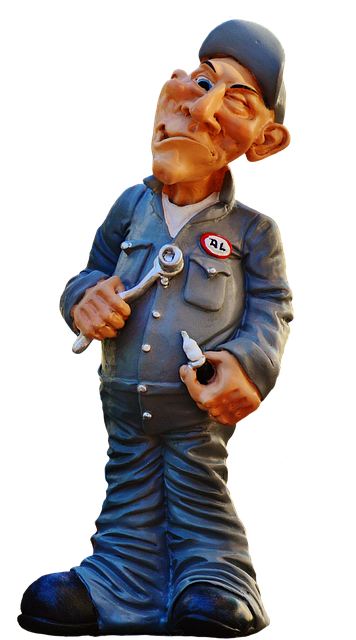Antique Auto Restoration: Key to Captivating Car Show Audiences
Antique auto restoration is a central attraction at car shows, revitalizing vintage vehicles with me…….
Welcome to an immersive journey into the captivating world of antique auto restoration, a meticulous art that breathes new life into vintage vehicles. This intricate process involves not just the physical reconstruction of classic cars but also preserves their historical significance and cultural value. In an era where innovation rapidly outpaces the past, antique auto restoration stands as a testament to our respect for automotive heritage. This article aims to delve deep into every facet of this fascinating craft, from its foundational principles to global implications, economic influences, technological innovations, regulatory frameworks, and future prospects. By exploring these diverse aspects, we will uncover why antique auto restoration is not merely a hobby but a vital component of cultural conservation.
Antique auto restoration, at its core, is the meticulous process of returning vintage automobiles to their former glory while ensuring their historical accuracy. It involves a blend of skill, knowledge, and passion, where restorers become modern-day conservators, carefully studying and replicating every detail that defines a particular era. This art encompasses more than just fixing and refurbishing; it requires an in-depth understanding of automotive history, construction techniques, and the unique challenges posed by each decade’s automotive evolution.
The journey begins with meticulous research, where restorers immerse themselves in the historical context of the vehicle they aim to restore. They scour through archives, consult old magazines, and study original design plans to capture every nuance. This foundational step ensures that the restoration remains true to its intended era, from the curves of art deco designs to the mechanical intricacies of early engines. The process then delves into disassembly, where each component is carefully taken apart, inspected, and assessed for repairs or replacements.
Restoration itself is a delicate dance, involving a skilled team of specialists. Bodywork restoration might include techniques like panel beating, metal fabrication, and paint mixing to match the original shade perfectly. Interior restoration demands an eye for detail in re-upholstering, installing period-correct accessories, and recreating the ambiance of yesteryears. Meanwhile, engine and mechanical restoration requires a deep understanding of the vehicle’s history to source authentic parts or replicate missing components accurately.
Antique auto restoration transcends borders, fostering a global community of enthusiasts and professionals. Its influence is felt across continents, each region contributing unique perspectives and styles while sharing a common love for vintage vehicles. Let’s explore some key trends and international impacts:
North America: The United States and Canada have long been recognized as hubs for antique auto restoration. With an abundance of classic cars from the 1950s and 1960s, restorers in these regions specialize in hot rods, muscle cars, and iconic models like Ford Mustangs and Chevrolet Camaros. The Goodwood Festival of Speed in the US is a testament to the country’s passion for classic car racing and restoration.
Europe: Europe boasts a rich automotive history, making it the birthplace of many iconic brands. Restorers here often focus on European classics like Jaguar E-Types, Porsche 356s, and vintage French cars. The British Motor Industry Heritage Trust plays a crucial role in preserving British automotive heritage through restoration projects.
Japan: Japanese restorers have gained international acclaim for their meticulous work on classic JDM (Japanese Domestic Market) cars. Models like the Toyota Land Cruiser, Nissan Skyline GT-R, and Mazda RX-7 have cult followings worldwide, with dedicated restorers ensuring these vehicles’ unique features are preserved accurately.
Emerging Markets: Countries in Asia, South America, and Africa are also making their mark in antique auto restoration. Restorers in these regions often work with limited resources but demonstrate incredible creativity and skill. For example, India has a thriving market for vintage Ford Model Ts, while Brazil is known for its passion for classic VW Beetles.
Antique auto restoration is not just a hobby or art; it is a significant economic sector with global implications. The industry’s economic impact is multifaceted, involving various markets and investment opportunities. Here’s a closer look:
| Economic Aspect | Description |
|---|---|
| Market Size | The global antique auto restoration market is estimated to be worth billions of dollars. With the increasing value of vintage cars at auctions and shows, the demand for restoration services has never been higher. |
| Investment Opportunities | Classic cars have become valuable investments, with some models appreciating by over 100% in recent years. Restorers often work on commission or offer restoration packages as a service, attracting wealthy collectors looking to preserve their automotive legacies. |
| Job Creation | The industry supports numerous jobs, from skilled restorers and mechanics to researchers, historians, and marketing professionals. Many small businesses and workshops depend on antique auto restoration as their primary revenue stream. |
| Tourism Boost | Classic car events and restoration centers attract tourists, boosting local economies. Cities like Carmel-by-the-Sea in California and Monterey, known for their automotive museums and shows, are prime examples of this economic synergy. |
Technology plays a pivotal role in antique auto restoration, revolutionizing how restorers approach their craft. Here are some significant advancements that have shaped the industry:
Computer-Aided Design (CAD): CAD software allows restorers to create precise digital models of vehicles, aiding in design and engineering. This technology ensures accurate measurements for reproduction parts and simplifies complex restoration projects.
3D Printing: 3D printing has transformed restoration by enabling the creation of exact replicas of hard-to-find or unique components. Restorers can now print custom parts, reducing lead times and costs compared to traditional manufacturing methods.
Digital Imaging and Photo Restoration: Advanced digital imaging techniques allow restorers to enhance old photographs, providing valuable visual references for their work. Photo restoration software can even reconstruct missing details, aiding in the accuracy of historical recreations.
Robotic Automation: In some cases, robotic arms are employed for precise welding and assembly tasks, increasing efficiency and consistency during restoration projects.
The antique auto restoration industry operates within a framework of policies and regulations that vary across jurisdictions. These rules are designed to protect historical vehicles, preserve cultural heritage, and ensure consumer safety. Here’s an overview:
Heritage Registration: Many countries have programs for registering and cataloging vintage vehicles, ensuring their authenticity and historical significance. Restorers must adhere to these guidelines, providing detailed documentation for each restoration project.
Import/Export Regulations: The import and export of antique vehicles are subject to customs regulations, often requiring permits and compliance with environmental standards. Restored cars intended for international sales must meet these requirements.
Safety Standards: Restoration work must comply with safety regulations, especially concerning structural integrity and mechanical systems. Restorers ensure that the final product meets or exceeds modern safety standards while maintaining historical accuracy.
Intellectual Property: Restorers must respect intellectual property rights, particularly when reproducing or using original design elements. This includes seeking permissions for certain logos, emblems, or unique styling features.
Despite its allure, antique auto restoration faces several challenges that restorers must navigate. Addressing these issues is crucial to ensuring the industry’s longevity and sustainability:
Availability of Parts: One of the most significant hurdles is sourcing authentic or period-correct parts. As vehicles age, finding exact replacements becomes more difficult. Restorers often resort to custom fabrication or 3D printing, adding to project costs.
Legal Disputes: Intellectual property rights and copyright issues can arise when restorers recreate specific models or use original designs. Legal clarity is essential to protect both restorers and consumers from potential disputes.
Ethical Concerns: Some critics argue that restoring vintage cars could lead to a lack of appreciation for modern automotive innovations. Balancing the preservation of history with a forward-looking perspective is crucial to addressing this concern.
Training and Certification: Ensuring restorers have adequate training and skills is vital. Standardized certification programs can improve quality control and set industry standards, fostering trust among consumers.
Let’s explore three remarkable case studies that highlight the art and impact of antique auto restoration:
Case Study 1: The Ferrari 250 GTO Restoration
In the world of classic Ferraris, the 250 GTO is a holy grail. A recent restoration project undertaken by a team of Italian experts became a global sensation. The car, originally produced in 1962, had seen better days when it was acquired by the restorers. After an extensive 3-year process, they achieved near-perfect accuracy, from the curved body panels to the engine’s intricate details. This restoration set new standards for quality and became a showcase for the precision required in vintage car conservation.
Case Study 2: Reviving the Buick Roadmaster
A team of restorers in Michigan took on the challenge of reviving a 1935 Buick Roadmaster. Their goal was not just to restore it but to make it drivable again, honoring its original glory. They meticulously replicated worn-out wood trim, restored the intricate grill work, and even recreated missing parts using period techniques. The successful restoration earned numerous awards and showcased the dedication required to bring these automotive icons back to life.
Case Study 3: Porsche 911 Restoration and Race Relevance
A restorer in Germany embarked on a project to restore a 1973 Porsche 911 to its original spec, aiming to compete in classic car racing events. This involved not just mechanical restoration but also recreating the car’s original race-ready condition. The project was a testament to the restorer’s expertise and the enduring relevance of antique autos in modern motorsports.
The world of antique auto restoration is constantly evolving, with new technologies, market trends, and consumer preferences shaping its future. Here are some potential growth areas and emerging trends:
Sustainability Focus: Restorers are increasingly adopting eco-friendly practices, using sustainable materials and methods wherever possible. This shift aligns with global efforts to reduce environmental impact while preserving automotive heritage.
Digital Marketplaces: Online platforms dedicated to antique autos will continue to grow, providing restorers with access to a global market for parts, resources, and even restoration projects.
Techno-Restoration Fusion: The integration of advanced technologies like virtual reality (VR) and augmented reality (AR) will enhance restoration processes. VR can simulate historical environments, aiding in research, while AR can overlay digital instructions during assembly.
Cultural Preservation Partnerships: Restorers may collaborate more closely with museums, historical societies, and cultural institutions to preserve significant automotive milestones as part of a broader cultural heritage narrative.
Antique auto restoration is not merely about restoring vehicles; it is about preserving a slice of history, honoring the past, and sharing it with future generations. This intricate craft demands a delicate balance between maintaining authenticity and embracing technological advancements. As we look ahead, the industry stands at a pivotal moment, poised to embrace new challenges and opportunities.
By exploring its various facets, from global trends to economic impacts and technological innovations, we have uncovered the profound significance of antique auto restoration. It is a testament to human creativity, a celebration of automotive history, and an integral part of cultural conservation. As restorers continue their meticulous work, they contribute to a living tapestry of historical vehicles, ensuring that our love for vintage cars remains vibrant and enduring.
Q: How do I know if a classic car restoration project is worth the investment?
A: Conduct thorough market research to understand the value of similar vehicles. Consult with experienced restorers who can provide insights into potential costs, rare or hard-to-find parts, and the overall demand for that specific model.
Q: Are there any legal requirements for restoring a classic car in my country?
A: Yes, regulations vary by region. Research local laws regarding heritage registration, import/export restrictions, safety standards, and intellectual property rights. Consulting with a legal expert specializing in automotive law can be beneficial.
Q: Can technology truly capture the essence of vintage cars?
A: While technology assists in restoration, capturing the essence of a vintage car goes beyond mechanical reproduction. It involves understanding the historical context, original design intent, and the unique character that makes each classic car special. Technology is a tool to aid in this process but cannot replace human expertise and passion.
Q: How can I protect my investment in a restored classic car?
A: Regular maintenance and upkeep are crucial. Keep detailed records of restoration work and parts used. Store the vehicle properly, away from direct sunlight and extreme weather. Consider insuring your classic car to protect against potential risks and damage.

Antique auto restoration is a central attraction at car shows, revitalizing vintage vehicles with me…….

Antique auto restoration is a growing field that combines historic preservation with environmental s…….

Antique auto restoration is a meticulous art that revives vintage vehicles, combining historical kno…….

In antique auto restoration, achieving true vintage excellence hinges on sourcing authentic parts. R…….

In antique auto restoration, using authentic parts from the same era is crucial for historical accur…….

Antique auto restoration is an art demanding deep automotive historical knowledge and specialized te…….

Antique auto restoration is a specialized art that meticulously revives historical vehicles while pr…….